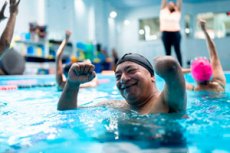Aerobic exercise is most effective for combating obesity-related inflammation
最近審查:14.06.2024

New research to be presented at this year's European Congress on Obesity (ECO) in Venice, Italy (12-15 May) reveals the anti-inflammatory properties of moderate to intense aerobic exercise in adults living with low-level inflammation due to obesity, highlighting its potential in preventing a variety of metabolic diseases, including type 2 diabetes and atherosclerosis (clogging of the arteries).
Excessive accumulation of fat in adipose tissue leads to chronic low-grade inflammation, which is characterized by chronically elevated levels of harmful compounds known as proinflammatory cytokines, which contribute to the development of metabolic diseases.
We know that exercise can reduce the risk of complications associated with obesity, and that new weight-loss drugs, such as glucagon-like peptide-1 receptor agonists (GLP-1 RA), originally developed for diabetes, are effective in reducing obesity and associated there are problems with him. In this analysis, we wanted to investigate whether combining exercise with GLP-1 RA could reduce chronic low-level inflammation in obese people, a process that underlies many chronic diseases and age-related conditions."
Sinje Torekov, lead author, professor, University of Copenhagen in Denmark
In the randomized, double-blind, placebo-controlled S-LITE trial, 195 Danish adults (mean age 42 years, 63% women) with obesity (BMI 32–43 kg/m²) but no history of diabetes followed an 8-week low-calorie diet. Diet (800 kcal/day) and lost at least 5% of their body weight (average loss was 13.1 kg).
Participants were then randomly assigned to a year of treatment with either placebo (usual activity plus placebo) or exercise (minimum 150/75 minutes of moderate/vigorous exercise per week as recommended by WHO, plus placebo), liraglutide (3 mg/day plus usual activity) or a combination of exercise and liraglutide treatment to maintain weight loss.
Participants self-administered placebo or liraglutide daily (depending on group).
The exercise program included two supervised sessions per week, mostly intense cycling exercise (assessed by heart rate), and participants were encouraged to complete two individual sessions per week to achieve a minimum of 150 minutes of activity per week.
Blood samples were collected before and after the low-calorie diet, as well as after a one-year treatment period, to measure changes in known factors of chronic inflammation - inflammatory cytokines such as interleukins (IL-2, IL-6, IL-8, IL-10, IFN-γ) and tumor necrosis factor alpha (TNF-α).
After one year, patients in the liraglutide-only group lost an additional 0.7 kg on average; patients in the exercise group gained an average of 2.0 kg; and participants in the placebo group regained approximately half of the weight lost (6.1 kg). However, participants in the exercise and liraglutide group lost an additional 3.4 kg on average.
Changes in inflammatory markers Following the low-calorie diet, TNF-α levels increased by an average of 8.4% and IL-10 levels by 11.7%. The remaining cytokines did not show significant changes after dietary intervention. TNF-α is associated with apoptosis (cell death), and the authors suggest that rapid weight loss leads to a transient increase in TNF-α as a marker of stress.
By the end of the one-year intervention period, the exercise group reduced IL-6 levels by an average of 31.9%, and by 18.9% compared to placebo. Chronically elevated levels of IL-6 are associated with cardiovascular diseases such as atherosclerosis and insulin resistance. The exercise group also reduced IFN-γ levels by an average of 36.6% and 37.2% compared to placebo. IFN-γ in obesity is associated with insulin resistance.
The liraglutide and combination groups reduced IL-6 levels by an average of 17.3% and 19.9%, respectively, during the intervention period, but there were no significant differences compared with placebo. However, there were no changes in IFN-γ levels in the placebo, liraglutide, or combination groups.
There were no significant differences in plasma concentrations of IL-2, IL-8, IL-10, and TNF-α between groups.
“Our results show that performing exercise as recommended is the most effective strategy for reducing chronic low-grade inflammation,” says Professor Torekov. "Treatment with liraglutide did not reduce inflammation more than placebo, and adding liraglutide to exercise did not reduce inflammation further. These results highlight the benefits of moderate-to-vigorous exercise in reducing low-level obesity inflammation, which may help prevent associated metabolic diseases."
The dropout rate was low. After one year, 41 of 49 randomized patients in the liraglutide group, 40 of 48 patients in the exercise group, 45 of 49 patients in the combination group, and 40 of 49 patients in the placebo group completed the study.

